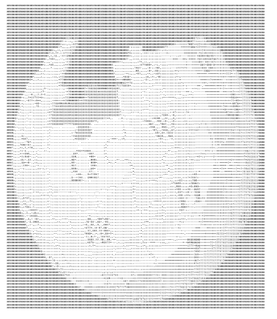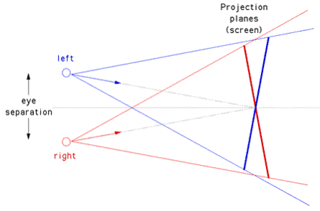
ASCII art is a graphic design technique that uses computers for presentation and consists of pictures pieced together from the 95 printable characters defined by the ASCII Standard from 1963 and ASCII compliant character sets with proprietary extended characters. The term is also loosely used to refer to text based visual art in general. ASCII art can be created with any text editor, and is often used with free-form languages. Most examples of ASCII art require a fixed-width font such as Courier for presentation.

Stereoscopy is a technique for creating or enhancing the illusion of depth in an image by means of stereopsis for binocular vision. The word stereoscopy derives from Greek στερεός (stereos) 'firm, solid', and σκοπέω (skopeō) 'to look, to see'. Any stereoscopic image is called a stereogram. Originally, stereogram referred to a pair of stereo images which could be viewed using a stereoscope.
In computer programming, the term magic number has multiple meanings. It could refer to one or more of the following:

Magic Eye is a series of books published by N.E. Thing Enterprises. The books feature autostereograms, which allow some people to see 3D images by focusing on 2D patterns. The viewer must diverge their eyes in order to see a hidden three-dimensional image within the pattern. The term "Magic Eye" has become something of a genericized trademark, often used to refer to autostereograms of any origin. The autostereogram predates the Magic Eye series by several years. Christopher Tyler created the first black-and-white autostereograms in 1979 with the assistance of computer programmer Maureen Clarke.
Near Instantaneous Companded Audio Multiplex (NICAM) is an early form of lossy compression for digital audio. It was originally developed in the early 1970s for point-to-point links within broadcasting networks. In the 1980s, broadcasters began to use NICAM compression for transmissions of stereo TV sound to the public.

An autostereogram is a single-image stereogram (SIS), designed to create the visual illusion of a three-dimensional (3D) scene from a two-dimensional image. In order to perceive 3D shapes in these autostereograms, one must overcome the normally automatic coordination between accommodation (focus) and horizontal vergence. The illusion is one of depth perception and involves stereopsis: depth perception arising from the different perspective each eye has of a three-dimensional scene, called binocular parallax.
The light field is a vector function that describes the amount of light flowing in every direction through every point in space. The space of all possible light rays is given by the five-dimensional plenoptic function, and the magnitude of each ray is given by the radiance. Michael Faraday was the first to propose that light should be interpreted as a field, much like the magnetic fields on which he had been working for several years. The phrase light field was coined by Andrey Gershun in a classic paper on the radiometric properties of light in three-dimensional space (1936).
A stereo display is a display device capable of conveying depth perception to the viewer by means of stereopsis for binocular vision.

Béla Julesz was a Hungarian-born American visual neuroscientist and experimental psychologist in the fields of visual and auditory perception.
The data URI scheme is a uniform resource identifier (URI) scheme that provides a way to include data in-line in Web pages as if they were external resources. It is a form of file literal or here document. This technique allows normally separate elements such as images and style sheets to be fetched in a single Hypertext Transfer Protocol (HTTP) request, which may be more efficient than multiple HTTP requests, and used by several browser extensions to package images as well as other multimedia contents in a single HTML file for page saving. As of 2021, data URIs are fully supported by most major browsers, and partially supported in Internet Explorer.
Random-dot stereogram (RDS) is stereo pair of images of random dots which when viewed with the aid of a stereoscope, or with the eyes focused on a point in front of or behind the images, produces a sensation of depth, with objects appearing to be in front of or behind the display level.
Christopher W. Tyler is a visual neuroscientist, creator of the autostereogram and is the Head of the Brain Imaging Center at the Smith-Kettlewell Eye Research Institute He also holds a Professorship at City University of London.

Anaglyph 3D is the stereoscopic 3D effect achieved by means of encoding each eye's image using filters of different colors, typically red and cyan. Anaglyph 3D images contain two differently filtered colored images, one for each eye. When viewed through the "color-coded" "anaglyph glasses", each of the two images reaches the eye it's intended for, revealing an integrated stereoscopic image. The visual cortex of the brain fuses this into the perception of a three-dimensional scene or composition.
Stereopsis is a term that is most often used to refer to the perception of depth and 3-dimensional structure obtained on the basis of visual information deriving from two eyes by individuals with normally developed binocular vision. Because the eyes of humans, and many animals, are located at different lateral positions on the head, binocular vision results in two slightly different images projected to the retinas of the eyes. The differences are mainly in the relative horizontal position of objects in the two images. These positional differences are referred to as horizontal disparities or, more generally, binocular disparities. Disparities are processed in the visual cortex of the brain to yield depth perception. While binocular disparities are naturally present when viewing a real 3-dimensional scene with two eyes, they can also be simulated by artificially presenting two different images separately to each eye using a method called stereoscopy. The perception of depth in such cases is also referred to as "stereoscopic depth".

A 3D stereo view is the viewing of objects through any stereo pattern.
Stereoscopic depth rendition specifies how the depth of a three-dimensional object is encoded in a stereoscopic reconstruction. It needs attention to ensure a realistic depiction of the three-dimensionality of viewed scenes and is a specific instance of the more general task of 3D rendering of objects in two-dimensional displays.

Wiggle stereoscopy is an example of stereoscopy in which left and right images of a stereogram are animated. This technique is also called wiggle 3-D or wobble 3-D, sometimes also Piku-Piku.
Stereoscopic acuity, also stereoacuity, is the smallest detectable depth difference that can be seen in binocular vision.
Stereoscopic motion, as introduced by Béla Julesz in his book Foundations of Cyclopean Perception of 1971, is a translational motion of figure boundaries defined by changes in binocular disparity over time in a real-life 3D scene, a 3D film or other stereoscopic scene. This translational motion gives rise to a mental representation of three dimensional motion created in the brain on the basis of the binocular motion stimuli. Whereas the motion stimuli as presented to the eyes have a different direction for each eye, the stereoscopic motion is perceived as yet another direction on the basis of the views of both eyes taken together. Stereoscopic motion, as it is perceived by the brain, is also referred to as cyclopean motion, and the processing of visual input that takes place in the visual system relating to stereoscopic motion is called stereoscopic motion processing.
![]() ). To help in focusing, try to make the two capital Os at the top look like three. Ensure that the image of the central dot is stable and in focus. Once this has been done, look down at the rest of the image and the 3D effect should become apparent. If the Os at the bottom of Figure 1 look like three, then the effect is reversed. It is also possible to obtain opposite 3D effects by crossing the eyes rather than diverging them (
). To help in focusing, try to make the two capital Os at the top look like three. Ensure that the image of the central dot is stable and in focus. Once this has been done, look down at the rest of the image and the 3D effect should become apparent. If the Os at the bottom of Figure 1 look like three, then the effect is reversed. It is also possible to obtain opposite 3D effects by crossing the eyes rather than diverging them ( ![]() ).
).![]() ), moving the viewer's head away from the screen increases the stereo effect even more. Moving horizontally and vertically a little also produces interesting effects.
), moving the viewer's head away from the screen increases the stereo effect even more. Moving horizontally and vertically a little also produces interesting effects.![]() )
)






